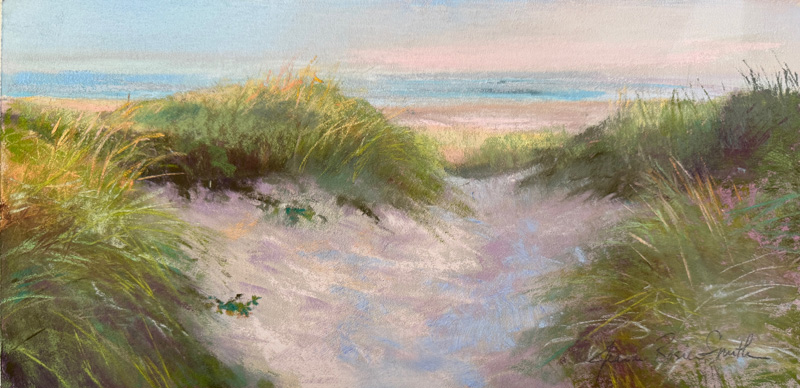Along the Dunes

In addition to a fascination with the sea’s ebb and flow, pastel artist Jeanne Rosier Smith is equally captivated by the shore’s sand dunes. Get her expert insight on painting these “waves” of sandy soil.
By Jeanne Rosier Smith
This article appears in the Summer 2024 issue of Pastel Journal. Get the full issue HERE.
Undulating, cresting and curving at the edge of ocean or lake, sand dunes mimic the moving water just beyond them. In fact, the dunes are also moving, just not as quickly or obviously as the waves. While this makes them more cooperative painting subjects, they still pose their own challenges. Low-lying sundrenched grass and sand might, at first glance, seem like a tough climb, but here are 15 tips that have made the dunes one of my favorite ongoing painting subjects. Most of these tips apply to work in any medium.
Photo References
Since I don’t live at the shore, I often rely on photo references when I’m painting. While they’re a powerful tool for catching compositional fodder, they’re far less reliable for color and value. (They make sand shadows too dark and blue, and sunny areas too flat and white). Painting from life whenever I get the chance reminds me of the dunes’ true values and colors—and gives me a better sense of how to adjust my photos digitally for a more realistic interpretation.

Composition
✓
Use light strategically. Dunes show off most at sunrise and sunset, when their curves throw shadows and catch highlights.
✓
Compose dunes using value shapes rather than land masses.
✓
Lower your point of view to find diagonals and to increase focal drama, as in Basking in Light.
✓
Anchor your composition with grasses; their windblown shapes offer color, contrast and linear variety.
Underpainting (in Pastel)
✓
Use cool reds under dark dune grasses, as in Underpainting (below). They complement layered greens and become local color for the dried grasses that form the dune base.
✓
Use warm, light oranges and yellows under sunny patches of dune grass, as seen around the dune rim in Underpainting.
✓
Place rosy pinks under sunny sand.
✓
Use warm neutrals in shadowed areas.
✓
Layer with warm and cool shades of similar value to create sand textures in the shadows. As planes change within a shadow shape, consider that their temperatures might also shift based on what the plane faces. For example, in Almost There, the values are close, but I layered the deepest blues along the right side. Adding a few warmer, lighter strokes facing toward the lightest areas of the sky reinforced the curved area of the dune path.


Sand
✓
Establish your values in the sun and shade first. Then, find warm and cool variations in each value to emphasize those temperature differences. For example, In the Hush of Dawn, the blue patch helps to convey that the sand is cool.
✓
Trust your eyes and keep in mind that sand reflects the sky and surroundings. In shadow, cooler colors of reflected sky predominate and mix with local, warm sand color. In light, sand reflects warmth, light, and sky.

Edges
✓
The light and shadow edge along the crest of a dune offers an opportunity for texture, stroke expression and focal point. Treat this area carefully by sharpening some edges and softening others, as in Summer Breeze.

Grasses
✓
Keep grass masses as simple as possible.
✓
Look for colors other than green among the grass, such as pink, peach, brown and gold. Start with dark areas and layer lighter.
✓
Add individual reeds as the final step; place them sparingly among grasses that catch the light, as in Summer Morning Memory.

Meet the Artist
Jeanne Rosier Smith, of Sudbury, Mass., is an award-winning pastelist. She’s a popular teacher and offers various online videos and instructional programs at EpiphanyFineArt.com.
From Our Shop



















Join the Conversation!